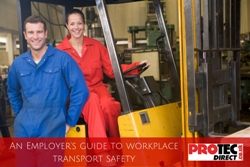Accidents are most common when people are on the move. The fact that ‘mass times acceleration equals force’ means risks are often significantly greater when in transit. When it comes to workplace safety, this is especially true; each year in the UK there are around 5,000 accidents as a result of employee transport, and about 50 of these result in deaths.
An Employer’s Guide to Workplace Transport Safety

What is workplace transport?
In order to understand the risks better, it’s useful to have a definition of workplace transport. Essentially, it involves any vehicle used in the workplace, such as forklifts, and excludes vehicles driven on public roads except when they are loading or unloading adjacent to the workplace.
What are the risks?
As you might expect, the main risks posed by workplace transport are people or objects falling from vehicles, collisions or being crushed. However, by implementing some basic safety principles it is possible to reduce the risks associated with transport. In fact, employers have a legal duty to ensure that all forms of transport that affect employees, contractors or members of the public, are risk assessed and maximise health and safety.
How to manage safety
There are three main areas where transport safety can be addressed. These are site safety, vehicle safety and driver safety.
Site safety
In order to have a safe site, you need to think about several key factors. These include ensuring vehicle and pedestrian pathways are separate, reducing the risk of collision. Traffic routes should be wide enough for vehicles to safely pass and avoid sharp slopes, corners or obstacles. They should run through areas where visibility is high with good road markings and signage to inform workers where to safely move. Of course, speed should be limited.
Vehicle safety
Vehicles should be correctly assessed for purpose. This is overseen by the Road Vehicles Regulations act from 1986, which sets the standard for suitable vehicles in working environments. This includes the fitting of beacons and sirens to ensure people are aware of the vehicles presence and movement. All transport should be subject to regular and thorough maintenance and inspection.
Driver safety
Drivers should be trained in operation and use of the specific vehicle. This involves adequate instruction, training and monitoring, especially when using younger or less experienced drivers. New recruits should be assessed for competence and existing employees should have their skills assessed regularly. It’s important that you keep abreast of the latest training news and information, if necessary, bringing in outside training to ensure quality. Drivers should also be assessed on their fitness to operate any vehicles they may be using.
Other issues
Any kind of workplace transport involves countless variables so you need to try and be aware of as many risks as possible. Visitors to the site who may not understand the rules, shared premises, and the use of contractors with poor training can all increase the risk of on-site transport.
Ultimately, working towards reduced accident and mortality rates is the goal. By following the advice in this guide you can do all you can to make this a reality.
Comments
Latest Blogs

An updated guide by consumer organization Which? looks at how to protect people’s ears. They focus on two main types of ear protection, earplugs and ear defenders.

A review submitted by the Department of Work and Pensions (DWP) has recommended that the Health and Safety Executive (HSE) should compel employers to improve their behaviour in issues of workplace health and safety.

Drivers are being urged to consider their footwear choices when behind the wheel, particularly during hot summer days when flip-flops are popular.

Leave a comment